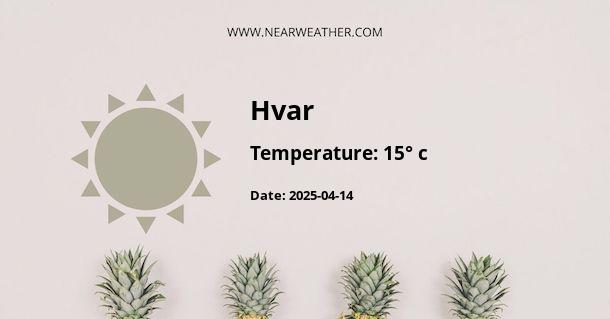The Climate and Weather of Hvar, Croatia
Hvar, an enchanting island in Croatia, is often celebrated for its stunning landscapes, historical treasures, and, most notably, its delightful Mediterranean climate. This sun-drenched island not only boasts an average of 2,724 hours of sunshine per year but also provides a compelling case study for the effects of regional climate characteristics on a local scale.
Overview of Hvar's Climate
Geographically positioned in the central Dalmatian archipelago, Hvar experiences a typical Mediterranean climate, which is characterized by mild, wet winters and hot, dry summers. This climate classification, known as "Csa" under the Köppen climate classification system, is defined by the transition between the wetter season (occurring in the mild winter) and the very dry summer period. Such patterns are heavily influenced by Hvar's situation along the Adriatic Sea, which moderates temperatures year-round.
Year-Round Weather Conditions
Let's delve into a detailed examination of what one might expect weather-wise during any given time of the year on this sun-soaked island.
Winter (December to February)
Winters are generally mild with average temperatures ranging from 5°C to 12°C (41°F to 53.6°F). While snow is exceedingly rare, rain is more common, contributing to the majority of Hvar's annual precipitation. The winter months can also see strong northerly winds, known as the Bura, which can cause sudden drops in temperature.
Spring (March to May)
Spring sees a gradual increase in warmth, with temperatures spanning from 10°C to 20°C (50°F to 68°F). Precipitation begins to decrease, and the famed Hvar lavender begins to bloom, dotting the landscape in shades of purple by late May.
Summer (June to August)
Hvar's peak tourist season coincides with its summer months, which feature hot, sunny days with minimal rainfall. Temperatures regularly reach upwards of 30°C (86°F), a perfect accompaniment to the island's numerous beaches and coves. The Maestral, a steady west-northwest wind, often provides some respite from the heat.
Fall (September to November)
Fall witnesses diminishing crowds and a pleasant decline in temperature to the range of 15°C to 25°C (59°F to 77°F). The weather remains stable, though rainfall does increase, especially in late fall. The grape harvest during this season is crucial for the island's celebrated wineries.
Statistical Weather Data for Hvar
For a more quantitative perspective on Hvar's weather, let us consider some typical meteorological data.
Temperature and Rainfall
| Month | Average High (°C) | Average Low (°C) | Average Rainfall (mm) |
|---|---|---|---|
| January | 11 | 6 | 82.1 |
| February | 11 | 6 | 75.1 |
| March | 14 | 8 | 65.3 |
| April | 17 | 11 | 64.2 |
| May | 22 | 15 | 55.6 |
| June | 26 | 19 | 48.3 |
| July | 30 | 22 | 24.1 |
| August | 29 | 22 | 56.1 |
| September | 26 | 19 | 76.2 |
| October | 21 | 15 | 97.4 |
| November | 16 | 11 | 113.3 |
| December | 12 | 7 | 103.8 |
Sunshine and Sea Temperature
Additionally, the annual sunshine hours and moderate sea temperatures are significant contributors to Hvar's appeal as a tourist destination.
- Annual Sunshine Hours: Approximately 2,724 hours
- Average Sea Temperature in Summer: 22°C to 27°C (71.6°F to 80.6°F)
On-the-Ground Weather Phenomena
Understanding local weather phenomena contributes to a more comprehensive understanding of Hvar's climate and weather patterns.
Local Winds
Two major winds affect Hvar: the Bura, a cold and usually dry northeasterly wind which can occur year-round but is more common in winter, and the Maestral, a daily, thermally induced wind which blows from the sea to the land during summer afternoons, providing a pleasant cooling effect.
Microclimates
The island also has specific microclimates, particularly in its inland areas, where the terrain is more elevated and rugged. These areas can experience slight variations in temperature and precipitation compared to coastal regions.
Climate Change Considerations
Climate experts have noted changes in Hvar's climate patterns, consistent with global climate change impacts. These include an increase in the severity and frequency of extreme weather events, such as heatwaves and droughts, and a shift in seasonal precipitation patterns. Local studies and projections suggest a warmer, drier future for Hvar, impacting agriculture, water resources, and tourism.
Conclusion
Hvar's climate is quintessentially Mediterranean, marked by clear seasonal shifts, an abundance of sunshine, and a temperate maritime influence. Its weather features are both a boon for travelers seeking solace in its warm summers and mild winters and a challenge due to the potential impacts of climate change. As a travel destination, Hvar remains a jewel in the Adriatic Sea, presenting an alluring climate that beckons visitors to its shores year after year.
For more specific and up-to-date weather forecasts, visitors are encouraged to consult reliable meteorological services prior to traveling.
A - Hvar's Latitude is 43.172501 & Longitude is 16.442780.
A - Weather in Hvar is 15° today.
A - Climate Conditions in Hvar shows moderate rain today.
A - Humidity in Hvar is 87% today.
A - Wind speed in Hvar is 50 km/h, flowing at 124° wind direction. today.
